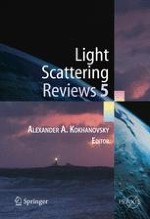2010 | OriginalPaper | Chapter
Code SHARM: fast and accurate radiative transfer over spatially variable anisotropic surfaces
Authors : Alexei Lyapustin, Tolegen Muldashev, Yujie Wang
Published in: Light Scattering Reviews 5
Publisher: Springer Berlin Heidelberg
Activate our intelligent search to find suitable subject content or patents.
Select sections of text to find matching patents with Artificial Intelligence. powered by
Select sections of text to find additional relevant content using AI-assisted search. powered by
Numerous numerical methods have been developed to solve a plane-parallel radiative transfer problem, including discrete ordinates (Stamnes et al., 1988; Spurr et al., 2001), spherical harmonics (Dave, 1975; Benassi et al., 1984), adding-doubling (Hansen and Hovenier, 1971; Twomey, 1985), successive orders of scattering (Lenoble et al., 2007) etc. An extended reference to numerical methods and publicly available codes can be found in Lenoble (1985), Ricchiazzi et al. (1998), Mayer and Kylling (2005) and Cahalan (2005). In this chapter, we describe the method of spherical harmonics (MSH), in particular its very efficient implementation developed by Karp et al. (1980) and, later, Muldashev et al. (1999). From a numerical standpoint, here are several main components of the spherical harmonics solution: (1) obtaining the system of linear differential equations of MSH, (2) its reduction to the system of linear algebraic equations using singular value decomposition (SVD), (3) use of a system’s matrix symmetry to halve its size for SVD transformation with ~8 times gain in speed, and finally, (4) angular smoothing of the solution for radiance calculations in arbitrary directions. The detail of MSH for the 1-D radiative transfer problem with a uniform surface, and for the 3-D problem with a spatially variable surface, are presented in sections 6.1 and 6.5, respectively. Section 6.2 provides an overview of the 1-D radiative transfer code SHARM (Muldashev et al., 1999; Lyapustin and Wang, 2005) which is one of the most numerically efficient scalar codes. SHARM performs simultaneous monochromatic calculations for multiple sun-view geometries, and allows the user to make multi-wavelength calculations in one run. The code is user-friendly, featuring built-in aerosol models and the most popular models of the bi-directional reflectance factor (BRF) of land and wind-ruffled water surface. Comparisons of SHARM with the benchmark code DISORT showed agreement to 0.02%.
